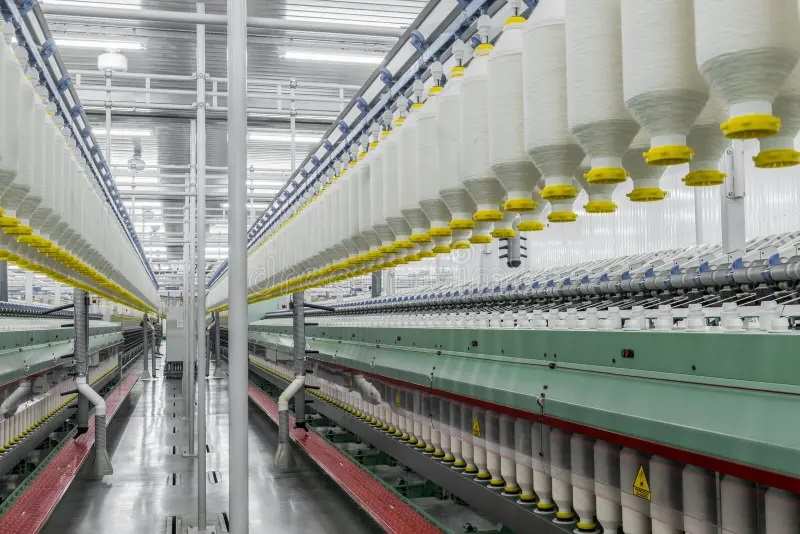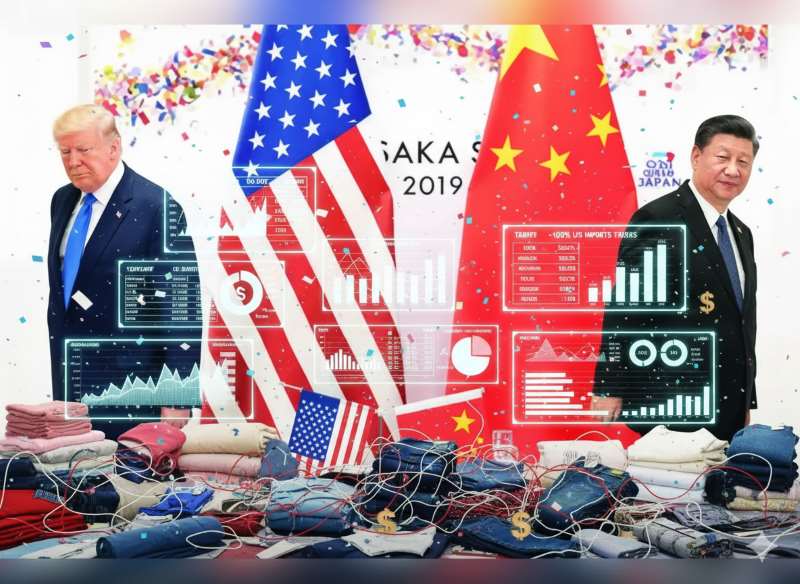FW
Hitesh Sanklecha, a textile trader who was fighting for the removal of GST on MMF fabrics, broke his 18-day-old hunger strike on Tuesday. Sanklecha, who was on a hunger strike on behalf of the 65,000 textile traders in the 165 markets here, broke his fast in the presence of his supporters at a public meeting near good luck market.
Among the huge presence of textile traders and workers at the public meeting, Sanklecha stated that since traders have bowed down before the government due to the weak leadership of the Textile GST Sangarsh Samiti (TGSS), he has no option but to end his hunger strike.
He further added that he has asked the TGSS to call a meeting of presidents and vice-presidents of all the 165 textile markets in the city to take their undisputed view on continuing the strike. At the STM meeting, there were representatives of a few markets and the FOSTTA declared that majority of people wanted the markets to reopen.
At the public meeting, the traders continued to shout slogans against Central government and Union finance minister Arun Jaitley. Hundreds of people hit the roads from Mahavir market and forced a few markets on their way to shut down after the public meeting was over. It was after the interference of the police, the crowds dispersed and a few protesters were arrested from the spot.
Indonesia’s textile exports in the first half of 2017 grew by 0.62 per cent year on year. This modest growth was supported by a 20.4 per cent year on year rise in knitwear exports. Indonesian textile exports to key markets have declined. Shipments to the US fell 3.6 per cent, to the European Union by four per cent and to Japan by nearly five per cent in the January-June 2017 period.
Since the start of the year Indonesia’s trade balance has improved markedly. Cheap imports have been discouraged. Imported products dominate 70 per cent of the domestic textile market. The aim is to make Indonesia competitive in the international market with other Asian major textile makers such as India, China, Vietnam and Bangladesh.
More than 50 garment factories have been relocated to Central Java where they have started using more efficient technology and therefore their output is more competitively priced on the world market, hence boosting demand. The textile and textile product sector contributed 8.2 per cent to Indonesia's total export earnings in 2016. Indonesia is one of the world’s largest textile manufacturers and exporters. The industry in Indonesia employs approximately 17 per cent of the country’s workforce and contributes significantly to the country’s economy.
By consistently adding new technology, Soyang Europe is assured of remaining at the forefront of the textile industry. A new display polyester has been added to the range along with a new black-back fabric and, with the ever-increasing popularity of large lightboxes for retail, the company has introduced a new backlit textile as well.
Its new display polyester is ideal for retail and exhibition graphics and is also printable with both dye sub and UV cure inks. A dense and compact structure enables users to achieve strikingly vibrant colors with dye sub or UV cure ink technology.
Meanwhile, the new black-back fabric is more suited to applications that require total block out. The range features for different finishes and offers solutions that can be used in lightweight woven or knitted structures up to 3.2m wide.
Soyang Europe’s new SoTex backlit has been launched in response to a spike in demand for oversized light boxes in retail stores, public spaces and exhibition halls. The range of grand-format backlit materials’ coating technologies and state-of-the-art yarns help deliver a premium finish.
The company, based in the UK, stocks options for UV, latex and dye sublimation ink technologies. Its products offer substantial benefits over alternatives. Soyang reports significant take-up by print service providers that run grand-format dye sublimation and UV hardware.
Retailers like H&M, Primark and several others are sourcing from Ethiopia. What attracts them is wage bills in Ethiopia are only a fifth of China’s and half of Vietnam’s. This makes the country one of the fastest growing economies in sub-Saharan Africa. Ethiopia is the second largest electricity producer in sub-Saharan Africa. The country’s power is among the cheapest in the world, is 86 per cent renewable and is on track to be 100 per cent renewable over time.
The country focuses on producing electricity from hydro, wind and geothermal sources. Ethiopia has launched a strategy to make the most of its potential in the textile sector.
The industry has advantages like power abundance and a growing human and material capital. It is witnessing rapid growth as a number of domestic and multinational firms are engaged in production of textiles, garments and apparel for domestic and global markets.
The country has Africa's largest industrial park. The flagship industrial park is capable of hosting gigantic multinational firms. It has a state-of-the-art waste treatment plant, the first of its kind in Africa. Ethiopia is also Africa’s second most populous country, with an average GDP growth rate of 11 per cent for the past 11 years and a stable government with an ambitious 2025 vision to become Africa’s leader in light manufacturing.
Although small-and-medium scale industry clusters have formed in the Mandalay region, local investors and businessmen are not interested in harnessing the business potential of these clusters, says U Myo Htut Swe, Director, Directorate of Industrial Supervision and Inspection.
Businessmen prefer to work individually. They do not like markets to be mixed as they trade only in the local market. There are clusters formed by firms in similar sectors. In the Mandalay Region, the Directorate of Industrial Supervision and Inspection formed industrial clusters since 2014 and there are now 111 groups in 15 industrial clusters.
The local business community needs to understand the advantages of tapping the potential of clusters. By doing so, the business community can discuss and share experience and find solutions to business problems to be more successful, says U Myo Htut Swe. The purpose of forming clusters is to encourage discussions and dialogues within the business community on issues such as how to penetrate the international market. Also, if there is a need to understand developments in the market such as advances in technology, the community can cooperate or invite experts to discuss topics. It should be like that, he added.
According to him authorities can help the business community foster the cluster mentality. That will empower local businesses and enable industries in Myanmar to compete internationally. The Directorate of Industrial Supervision and Inspection is now providing training to local businessmen with the help of foreign countries and helping to foster an interest in forming clusters among the local business community.
U Ye Win Aung, associate secretary of Mandalay Industrial Zone Management Committee, stated that while clusters can gradually be formed, distinctive changes will not quickly be seen.
Inditex’s president Pablo Isla feels a sustainable growth strategy is key to the future of the group, which is “totally” focused around a circular economy centered on people, social aspects, the environment and the product’s quality.
Speaking at a recent shareholders meeting Isla analysed the company’s evolution and data from the 2016 period and cited “sustainable growth” as “something absolutely essential. He also referred to growth that is solid and integrated as key to the future of Inditex, which he defined as a company “centered on people, based on creative talent and with an integrated model of physical and online stores.”
The board approved the 2016 results, which allowed for dividends of €0.68 per share, representing a 13.3 per cent increase from the previous year and an 89 per cent growth over the past five years, which suggests an attractive and certain remuneration policy for shareholders. Isla also indicated the group’s goal to implement its short and long-term strategy across the world, as a phenomenon such as Brexit won’t affect the shares and investment plans in the UK.
He stressed on the “solid growth model” for the group, which has seen comparable growth rates of 69 to 37 per cent in the past five years, with positive outcomes across all regions. With regards to “sustainable growth strategy” based on a circular economy, Isla cited transparency in supply chain management, adequate working conditions, occupational health and safety, dignified salaries, collective negotiations for factories, female empowerment and protection for migrants as key principals.
In 2016, the group raised 1.4 billion euros in funding and will exceed 7 billion in the next five years. A large portion of that has been spent on technological advances such as the RFID system. It’s estimated that in 2018 the technology will reach the remainder of the group’s brands.
Technical textile exports from the EU grew 2.4 per cent during 2016, says Euratex. It accounted for 38 per cent of total textile exports by the EU last year. The major importer was the US, which purchased 20 per cent of total technical textile exports by the EU. Menswear exports from the EU were 23 per cent of total apparel exports by the EU. Switzerland, the major menswear importer from the EU, saw a drop in value of imports by 3.9 per cent.
Meanwhile, the EU witnessed double-digit growth in value-wise menswear exports to South Korea, Australia, Serbia, Mexico, Israel and Ukraine. Trousers, shirts and coats were the top exported products in the menswear category with a share of 32 per cent, 19 per cent and 17 per cent respectively.
Menswear imports also jumped during the year. The share of menswear imports in value terms was 28 per cent, whereas volume-wise it contributed 25 per cent to total apparel imports by the EU. Menswear imports soared 0.5 per cent in value and 4.4 per cent in volume terms. During 2016, imports of womenswear too improved significantly. The segment improved by 0.8 per cent, contributing 36 per cent to total apparel imports by the EU. China, Bangladesh and Turkey were the top exporters of womenswear to the EU.
Designers are looking to forests for clothing ideas. They are moving away from old-fashioned materials like cotton, silk or leather. Forests have a lot to offer. Yarns from cypress, beech and eucalyptus trees, not to mention cork, are softer and more breathable than cotton or silk. Fabrics similar to animal skins can instead come from hardwoods and conifers.
Fashion students in Italy have been creating a collection of clothing and accessories made entirely from wood and wood-based products. Large and globally recognized fashion brands are working to change their supply chain to avoid endangering forests. The world's largest apparel makers are removing endangered and ancient forests from their dissolvable pulp supply chain for their viscose and rayon fabrics. They are giving themselves three years to find alternative sources, including straw and recycled fabrics.
Around 30 per cent of the rayon and viscose going into clothing comes from dissolvable pulp sourced from endangered and ancient forests. Manmade cellulosic fabrics like rayon, viscose and lyocell are created from trees cut down exclusively to feed dissolving pulp mills.
Forest-based fabrics represent five per cent of the global apparel industry and that number is poised to grow. Demand for dissolving pulp is projected to double in the next 20 years and is increasing at a nine per cent rate annually.
Bangladesh has started amending its labor laws under pressure from the International Labor Organisation and the European Union. The amendment may be done by the end of August. Some basic changes will be made. The worker percentage needed to form a trade union in a factory may be brought down.
Current law, which was hurriedly amended in July 2013 three months after the Rana Plaza building collapse, requires collection of signatures of 30 per cent of the workers in a factory to form a trade union. The suggested amendment says, if a factory has 500 workers, 30 per cent must sign up for a trade union; if the number of workers is 5000, about 10 to 15 per cent of them need to give their signatures. But not more than three unions in a factory will be allowed although the international community demands a higher number.
The country is also working to amend the labor law of the export processing zones. The EU has already warned Bangladesh of suspension of the GSP under the EU's Everything But Arms scheme if labor rights are not improved further. Bangladesh has committed to amending labor laws by the end of August.
Maredamare will be held in Italy from July 22 to 24, 2017. This is a beach wear trade fair where around 200 Italian and foreign brands will present beach wear and accessories collections for summer 2018. Fashion shows, theme-based workshops and meetings, exclusive presentations and events are lined up.
The main theme is a tribute to graphics and geometric patterns that make surfaces alive. The source is minimalistic and unconventional, sometimes audacious. Micro and macro motifs are wisely balanced as to make spaces more lively and vital; a sophisticated kind of luxury is reached through the wise development of the most unusual geometries.
Sport Couture is a sophisticated interpretation borrowed from the technical universe. It is realised through minimal graphics, color blocks or small and nearly unnoticeable all-overs that leave room to the performance of the fabric. Cuts are simple. Bikinis and one-piece bathing suits are inspired by water and beachwear sports.
Hippie Boho is nomad, rebellious and adventurous. It represents a journey to faraway sun-burnt lands, a voyage to the discovery of signs and patterns borrowed from remote universes. Gypsy prints and abstract patterns blend with stripes and floral motifs.
Powerful Rainforest represents a nature explosion in its full power. Flora and fauna prints with saturated and majestic tones characterise this trend.












